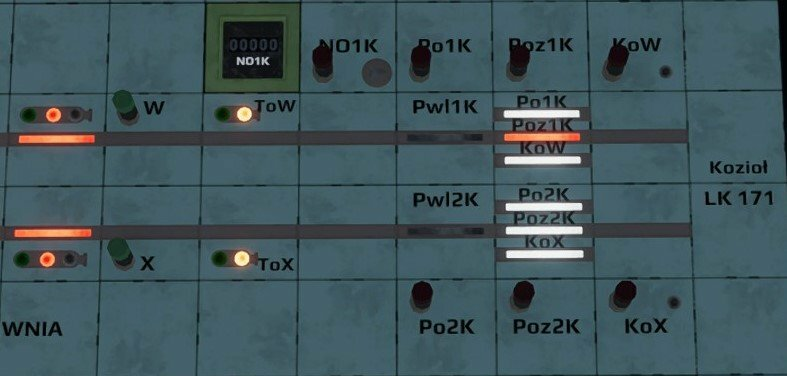Translations:How to operate relay line block equipment/10/en: Difference between revisions
(Importing a new version from external source) |
(Importing a new version from external source) |
||
| Line 1: | Line 1: | ||
== | ===== ''Example of stacked block fields'' ===== | ||
The | [[File:961196655 20230124202318 1(2).jpg.png|center]] | ||
The permission field is set up when a track is used in both directions as scheduled. This is the case for single-track lines and for double-track lines equipped with main signals in both directions. In second case, the instructions for the operation of "NO" and "NP" as described for SBL systems (see below) apply in analogy, in case movements take place on the opposite track. | |||
The permission field is also connected to the according permission field of the neighbouring interlocking. If it is blocked (red), the neighbouring signal box may release a train. If the permission field is unblocked (white), we are allowed to release a train. If the permission field is blocked, the exit signals in the direction of the track are held in stop position. Only one signal box can have the permission for one track at a time. The permission field can only be operated when all other block fields are unblocked (white) and line repetition interlock is not in effect. | |||
The starter field is connected to the end field of the neighbouring signal box. In default position it is unblocked (white). This means that the track is free of any vehicles. If the starter field is being blocked (red), the line is considered to be occupied. If we operate the starter field in our interlocking, the end field is operated in the neighbouring signal box and vice versa. | |||
The end field is connected to the starter field on the neighbouring signal box. Here, too, the default position is unblocked (white) and blocked when the line is occupied (red). As soon as the end field is unblocked, the track is clear again for another train. | |||
The block fields are dependent to the signals of the signal boxes in various ways and cannot be operated loosely. | |||
Latest revision as of 01:58, 18 April 2024
Example of stacked block fields
The permission field is set up when a track is used in both directions as scheduled. This is the case for single-track lines and for double-track lines equipped with main signals in both directions. In second case, the instructions for the operation of "NO" and "NP" as described for SBL systems (see below) apply in analogy, in case movements take place on the opposite track. The permission field is also connected to the according permission field of the neighbouring interlocking. If it is blocked (red), the neighbouring signal box may release a train. If the permission field is unblocked (white), we are allowed to release a train. If the permission field is blocked, the exit signals in the direction of the track are held in stop position. Only one signal box can have the permission for one track at a time. The permission field can only be operated when all other block fields are unblocked (white) and line repetition interlock is not in effect. The starter field is connected to the end field of the neighbouring signal box. In default position it is unblocked (white). This means that the track is free of any vehicles. If the starter field is being blocked (red), the line is considered to be occupied. If we operate the starter field in our interlocking, the end field is operated in the neighbouring signal box and vice versa. The end field is connected to the starter field on the neighbouring signal box. Here, too, the default position is unblocked (white) and blocked when the line is occupied (red). As soon as the end field is unblocked, the track is clear again for another train. The block fields are dependent to the signals of the signal boxes in various ways and cannot be operated loosely.
